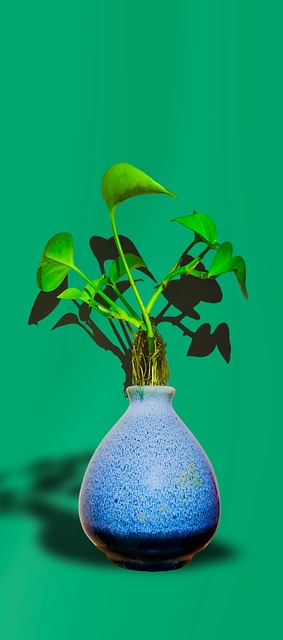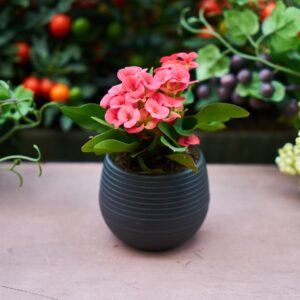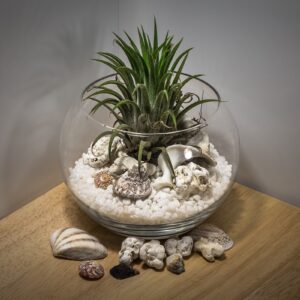Are you looking to add some life and color to your home decor? Look no further than houseplants! Not only do they bring a touch of nature indoors, but they can also complement your room’s colors and textures. With a little bit of planning and creativity, you can use houseplants to enhance the overall aesthetic of your living space.
When choosing houseplants for your home, consider the colors that already exist in your room. You can create a cohesive look by selecting plants that complement these colors. For example, if you have a room with neutral tones, you could add a pop of color with a bright green plant like a snake plant or a fiddle leaf fig.
Alternatively, if you have a room with bold colors, you could choose a plant with more muted tones like a peace lily or a spider plant. By strategically selecting plants based on the existing colors in your space, you can create a harmonious and visually appealing environment.
Choosing Houseplants that Complement Your Room’s Colors
You don’t want your room to look like a random jungle, do you? That’s why it’s important to choose houseplants that enhance the colors already in your space.
Color psychology plays a role in determining which plants to select. For example, green plants are known to promote a sense of calmness, while blue plants offer a calming effect. Red plants, on the other hand, are known to increase energy levels.
Additionally, natural lighting should be considered when placing your houseplants. If your room gets a lot of natural light, you may want to choose plants with darker leaves that can handle the extra sun exposure. On the other hand, if your room doesn’t get much natural light, you may want to opt for plants with lighter leaves that can thrive in lower light conditions.
By considering both color psychology and natural lighting, you can choose houseplants that complement your room’s colors and create a cohesive, inviting space.
Matching Plant Textures with Your Decor
Matching the textures of your plants with your furnishings can add visual interest to your space and increase your overall sense of well-being, according to a study published in the Journal of Environmental Psychology.

Mixing textures can create a more dynamic and layered look in your decor. For example, if you have a lot of smooth surfaces in your room, such as a glass coffee table or a sleek leather sofa, consider adding some plants with rougher textures, like a snake plant or a cactus, to add some visual contrast.
Another aspect to consider is natural vs. artificial plant decor. While artificial plants can be a convenient option for those who don’t have a green thumb, they often lack the texture and depth of real plants.
If you do choose to go the artificial route, look for plants that have that same visual interest and texture as their real counterparts. However, if you’re able to care for real plants, they can bring a whole new level of texture and life to your decor.
Choose plants with interesting leaves, like a fiddle leaf fig or a bird’s nest fern, or ones with unique textures, like a string of pearls or a rubber plant.
Creating Contrast with Houseplant Colors
Adding some pop and contrast to your space can be achieved by incorporating colorful houseplants. Pairing contrasting colors can create a dynamic visual experience and add energy to a room.
For example, if your space is primarily decorated in cool tones, consider adding a pop of warmth with a vibrant red or orange plant. On the other hand, if your space is filled with warm tones, balance it out with a cool-toned plant like a snake plant or aloe vera.
Mixing and matching textures can also play a role in creating contrast with houseplant colors. A glossy-leaved plant, like a rubber plant, can be paired with a matte-textured plant, like a pothos, to create a visually interesting display.
Additionally, adding a trailing plant like a string of pearls or a spider plant can add dimension and movement to a space. Don’t be afraid to experiment with different combinations and placements to find the perfect contrast and balance for your decor.
Incorporating Houseplants as Statement Pieces
Incorporating houseplants as statement pieces can elevate the style of your space and create a unique focal point that guests will admire and remember.
Houseplants can be used as focal points, not just accents, by choosing plants that are tall and dramatic, or by creating vertical displays using unique containers.
When selecting plants for your statement pieces, consider their size, shape, and color. For example, a tall fiddle leaf fig in a minimalist white pot can add a touch of modern elegance to a room, while a hanging spider plant in a macrame hanger can create a bohemian vibe.
Additionally, using unique containers, such as vintage urns or geometric terrariums, can add an unexpected element to your design.
By using houseplants as statement pieces, you can easily add both style and health benefits to your space.
Using Houseplants to Tie Together Different Rooms in Your Home
You’ll be amazed at how seamlessly your home flows when you use plants to connect each room, creating a natural and tranquil atmosphere that will leave you feeling relaxed and rejuvenated.
One way to achieve this is by using hanging plants to create a vertical link between multiple levels. Hang a plant in your living room, and then another in your hallway or entryway – this will create a cohesive flow between these two spaces, and help tie your home together.
Another tip is to group plants together in clusters, creating a natural transition from one room to the next. For example, if you have a collection of plants in your living room, consider placing a few more in your dining room or adjacent space. This will create a visual connection between the two areas, making them feel like a natural extension of one another.
By using plants to connect different rooms, you’ll not only create a cohesive flow throughout your home, but also add a touch of nature that’ll help you feel more grounded and relaxed.
Frequently Asked Questions
What are some low maintenance houseplants that can be used for color coordination?
So, you want to add some color to your home but don’t want the hassle of high maintenance houseplants? Well, fear not my friend, because there are plenty of options for low maintenance plants that can still add a pop of color to your space.
Some of the best color combinations include a deep green snake plant paired with a bright yellow pot, or a vibrant purple African violet in a white ceramic container.
As for tips for placement, consider adding a splash of color to a windowsill or a bookshelf to liven up the area.
With these easy-to-care-for plants, you can add some color to your home without adding any extra stress to your life.
How can I incorporate houseplants into a small space without overwhelming the room?
If you’re working with a small space, there are still plenty of ways to incorporate houseplants without overwhelming the room. Maximizing vertical space is key – try hanging plants from the ceiling or using wall-mounted planters to add greenery without taking up valuable floor space.
Creative placement ideas can also make a big impact – consider grouping small plants together on a bookshelf or windowsill, or using larger plants as a focal point in a corner. Remember to choose plants that fit the light and humidity conditions of your space, and don’t be afraid to experiment with different sizes and textures to create a dynamic and visually interesting display.
Are there any houseplants that are not suitable for certain color schemes?
When it comes to choosing the right houseplants for your home, it’s important to consider more than just their size and care requirements. Matching plant textures and avoiding color clashes are key factors to keep in mind when trying to create a cohesive color scheme.
While there aren’t necessarily any houseplants that are off-limits for certain color schemes, it’s important to pay attention to the overall look and feel you’re trying to achieve. For example, if you have a lot of bold, bright colors in your home, you might want to opt for more muted, neutral-toned plants to balance things out.
On the other hand, if your space is more subdued, you could consider adding a pop of color with a bright, statement plant. By paying attention to these details, you can create a beautiful and harmonious space that truly feels like home.
Can I use artificial houseplants to achieve the same effect as live plants?
If you’re not up for the challenge of caring for live houseplants, artificial ones can be a great alternative. The advantages of artificial houseplants are numerous, including the fact that they require no maintenance, can be placed anywhere without worrying about sunlight or water, and can last for years.
When choosing realistic artificial plants, there are a few tips to keep in mind. Look for plants with varying shades of green, as well as leaves with different textures and shapes to mimic the diversity of real plants. Consider the size and shape of the plant, as well as the container it comes in, to ensure it fits seamlessly into your space.
With the right selection, your artificial plants can bring all the beauty and benefits of live plants without the upkeep.
How can I prevent my houseplants from clashing with existing decor elements such as wallpaper or furniture?
To prevent your houseplants from clashing with existing decor elements, you can use accent colors and create a color palette that complements both the plants and the room.
Choose plants with leaves that have colors that match or complement the colors in your decor, or use pots that coordinate with your furniture or wallpaper.
You can also use contrasting colors to create a bold statement, but be sure to use them sparingly.
Consider the overall mood and style of the room and choose plants that fit that aesthetic.
By carefully selecting and arranging your houseplants, you can create a cohesive and beautiful space.
Conclusion
Congratulations! You’re now equipped with some great tips for incorporating houseplants into your home decor.
Remember to choose plants that complement your room’s colors, matching textures with your decor, and creating contrast with houseplant colors.
Houseplants can be used as statement pieces or to tie together different rooms in your home.
For example, let’s say you have a living room with a neutral color scheme of beige and white. Adding a pop of green with a monstera plant can make a big impact in the room. The large, glossy leaves of the monstera create a beautiful contrast against the neutral tones of the room. Additionally, the monstera’s texture complements the woven rug and wooden coffee table in the space.
By following these color coordination tips, your houseplants can become an integral part of your home decor. Not only do they add beauty and life to your space, but they also have numerous health benefits.
So go ahead and experiment with different houseplants to find the perfect match for your decor style.
Happy decorating!





